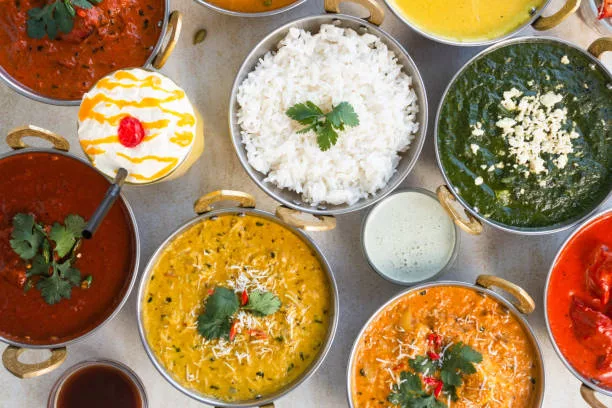Indian vegetarian cuisine is a vibrant tapestry of flavors, colors, and aromas that celebrates a diverse range of ingredients and cooking techniques. Rooted in centuries-old traditions and influenced by regional diversity, Indian vegetarian dishes offer a tantalising array of options for both everyday meals and festive occasions.
The heart of Indian vegetarian cooking lies in its ingenious use of spices and herbs, creating a symphony of tastes that cater to a variety of palates. Ingredients like cumin, coriander, turmeric, cardamom, and garam masala infuse dishes with depth and character, while fresh herbs like cilantro and mint add a refreshing touch.
Staples like lentils, chickpeas, rice, and a myriad of vegetables form the foundation of many Indian vegetarian dishes. From the humble yet versatile dal (lentil soup) to elaborate biryanis and stuffed parathas, the range of creations is extensive.
Here are top 10 Quick and Delicious Indian Vegetarian recipes:
- Palak Bhurji: Palak bhurji is a flavourful dish where finely chopped spinach leaves are sautéed with a blend of spices, including cumin, turmeric, and red chili powder. It often incorporates onions, tomatoes, and garlic, creating a medley of textures and tastes.

- To prepare palak bhurji, the spinach is typically washed thoroughly, finely chopped, and then cooked with oil or ghee in a pan. The spices are added to infuse the spinach with their aromatic essence. Onions and garlic are often sautéed until golden brown before adding tomatoes, allowing them to soften and release their flavors.
- In some variations, scrambled eggs are mixed into the spinach mixture, adding a protein-rich element to the dish. The eggs are whisked separately and then combined with the sautéed spinach, creating a fusion of flavours.
- Palak bhurji is a versatile dish that can be enjoyed as a side dish with bread like chapati or paratha, or even as a filling for wraps or sandwiches. Its simplicity, coupled with the richness of spices and the freshness of spinach, makes it a popular and wholesome choice in Indian cuisine.
2. Gobhi masaledar: Gobhi masaledar is a vibrant and flavourful Indian dish that celebrates the humble cauliflower, known as “gobhi” in Hindi. It’s a delightful preparation where cauliflower florets are cooked with a medley of spices, creating a rich and aromatic experience for the taste buds.

- To make gobhi masaledar, the cauliflower is typically cut into florets and often blanched or lightly fried to retain its texture before being incorporated into the masala (spice mix). The masala blend can vary but commonly includes spices like cumin seeds, turmeric, coriander, garam masala, red chili powder, and sometimes kasuri methi (dried fenugreek leaves), which add depth and complexity to the dish.
- The cooking process involves sautéing the spices in oil or ghee until they release their fragrant aromas. The cauliflower florets are then added to the spice mix, allowing them to absorb the flavors while being cooked to tender perfection. Sometimes, additional ingredients like onions, tomatoes, ginger, and garlic are incorporated to enhance the taste further.
- Gobhi masaledar showcases the versatility of cauliflower, transforming it into a dish that’s both comforting and bursting with zesty flavors. It’s often served as a side dish alongside main courses like rice or bread, such as roti or naan, making it a beloved addition to Indian meals.
3. Hyderabadi baingan: Hyderabadi Baingan, also known as Bagara Baingan, is a tantalizing dish that hails from the culinary heritage of Hyderabad, India. This dish revolves around baby eggplants cooked in a rich and aromatic gravy that’s infused with a blend of spices and tangy tamarind.

- The eggplants are often slit or partially cut in a cross-hatch pattern, allowing the flavors of the spices and gravy to penetrate and infuse the vegetable. These small eggplants are then typically pan-fried or shallow-fried until they develop a tender texture and a slightly crispy exterior.
- In a pot or skillet, this paste is sautéed with onions, tomatoes, ginger, and garlic, creating a fragrant and rich base. Tamarind paste or pulp is often added to lend the dish its signature tangy flavor, balancing the richness of the spices.
- The fried eggplants are then gently added to this luscious gravy, allowing them to soak up the flavors while simmering until they reach a melt-in-your-mouth tenderness. The dish is often garnished with fresh coriander leaves or chopped cilantro for a burst of freshness.
4. Arbi ki kadhi: Arbi ki kadhi is a traditional Indian dish that features taro root (arbi) cooked in a tangy and spiced yogurt-based gravy. This dish is popular in various regions across India and offers a unique and comforting taste.

- The preparation typically begins by peeling and slicing the taro roots into rounds or cubes. These pieces are then parboiled or partially cooked to soften them before being added to the kadhi.
- The kadhi, or the spiced yogurt gravy, forms the flavorful base of the dish. It’s made by whisking together yogurt, besan (gram flour), and water to create a smooth mixture. This mixture is then gently cooked with spices like cumin seeds, mustard seeds, fenugreek seeds, curry leaves, turmeric, and sometimes ginger and green chilies.
- Once the kadhi reaches a smooth consistency, the partially cooked taro root pieces are added to the simmering gravy. The dish is allowed to cook further until the taro root absorbs the tangy and spiced flavors of the kadhi, becoming tender and infused with the delicious essence of the sauce.
- Arbi ki kadhi is often garnished with fresh coriander leaves and sometimes a tadka (tempering) of spices sizzled in oil is poured over the top just before serving, enhancing the dish’s aroma and taste.
5. Bharwan Tinda: Bharwan Tinda is a flavourful and savory Indian dish that highlights the use of round gourds called “tinda.” These gourds are hollowed out and stuffed with a spiced mixture, creating a dish that’s both visually appealing and delicious.

- The preparation of Bharwan Tinda begins by carefully removing the tops of the tinda and scooping out the seeds and pulp, leaving a cavity perfect for stuffing. The stuffing is usually a mixture of spices, often including ingredients like roasted gram flour (besan), ground spices such as cumin, coriander, turmeric, red chili powder, and sometimes crushed nuts like cashews.
- The hollowed-out tinda are then generously filled with this flavorful stuffing, ensuring that each gourd is packed with the aromatic mixture. The tops of the tinda are replaced to seal in the stuffing, and they are often secured with toothpicks to keep them intact during the cooking process.
- These stuffed gourds are typically cooked in a pan with a bit of oil. They are gently sautéed or sometimes cooked in a tomato-based gravy, allowing the flavors to meld together while the tinda become tender.
- Bharwan Tinda is appreciated for its unique taste, where the mild and slightly sweet flavour of the gourd melds with the spicy and aromatic stuffing, creating a delightful contrast of textures and tastes. The dish is often garnished with fresh coriander leaves before serving, adding a touch of freshness to the flavors.
6. Undhiyu: Undhiyu is a traditional Gujarati vegetable medley that embodies the vibrant flavors and seasonal produce of India. This beloved dish is a celebration of winter vegetables and is often prepared during the festival of Uttarayan (Makar Sankranti).

- The name “Undhiyu” roughly translates to “upside down” in Gujarati, referring to the traditional method of cooking where the dish is cooked upside down in an earthen pot (matla) buried in the ground. However, modern adaptations often involve cooking it in a pan or pressure cooker.
- Undhiyu is a rich and aromatic concoction that combines a variety of vegetables like purple yam (kand), baby potatoes, eggplant, raw banana, fenugreek leaves (methi), and more. These vegetables are typically chopped or diced and mixed with a blend of spices, including ginger, garlic, green chilies, turmeric, coriander, and cumin.
- The highlight of Undhiyu is its unique green masala, made from fresh coriander leaves, green chilies, coconut, and other aromatic ingredients, ground into a vibrant paste. This masala infuses the dish with its distinctive flavor profile.
- Traditionally, Undhiyu is assembled in layers, with the tougher vegetables placed at the bottom and the more delicate ones on top. The pot is then sealed with a dough made from wheat flour to ensure the flavors and moisture are locked in during the cooking process.
- The dish is slow-cooked to perfection, allowing the vegetables to absorb the rich spices and develop a harmonious blend of flavors. Undhiyu is often garnished with chopped cilantro, shredded coconut, and sometimes a squeeze of lime before serving.
7. Methi Aloo: Methi aloo is a delightful Indian dish that combines the earthy bitterness of fenugreek leaves (methi) with the comforting taste of potatoes (aloo). This simple yet flavorful dish is a popular choice in Indian households, celebrated for its unique blend of spices and textures.

- To prepare methi aloo, fresh fenugreek leaves are washed thoroughly and chopped finely, then sautéed with spices like cumin seeds, turmeric, red chili powder, and sometimes coriander powder. These aromatic spices infuse the fenugreek leaves with their rich flavors while tempering the bitterness.
- Potatoes, usually diced or cubed, are added to the spiced fenugreek mixture. They absorb the flavors of the spices and fenugreek leaves as they cook, creating a harmonious blend of tastes. Some variations include adding tomatoes, onions, ginger, or garlic to enhance the dish further.
- Methi aloo is cooked until the potatoes reach a tender consistency, and the fenugreek leaves become wilted yet retain their distinct flavour. The dish is often garnished with a sprinkle of garam masala or fresh coriander leaves before serving, adding an extra layer of aroma and taste.
8. Crispy Andhra Bhindi: Crispy Andhra Bhindi is a tantalizing dish that showcases the vibrant flavors of okra (bhindi) in a crispy, spiced coating. Hailing from the Andhra Pradesh region of India, this dish offers a delightful twist to the traditional preparation of okra.

- The recipe typically starts by washing and thoroughly drying the okra to ensure it’s free from moisture, which helps achieve the desired crispiness. The okra pods are then sliced lengthwise or into rounds, depending on preference.
- A mixture of spices and gram flour (besan) is prepared, often including ingredients like turmeric, red chili powder, coriander powder, cumin, amchur (dry mango powder), and salt. This spice blend is generously coated onto the sliced okra, ensuring an even distribution of flavors.
- The coated okra is usually shallow-fried or deep-fried in hot oil until it turns crispy and golden brown. The besan coating lends a crunchy texture while locking in the flavors of the spices, creating a savory and aromatic profile.
- Crispy Andhra Bhindi is known for its unique blend of spices that add a kick of heat and tanginess, perfectly complementing the natural taste and texture of the okra. It’s often served as a side dish with rice or Indian bread, such as roti or naan.
9. Gatte ki Sabji: Gatte ki sabji is a cherished Rajasthani dish that features gram flour (besan) dumplings cooked in a flavourful yogurt-based curry. This dish is a celebration of traditional Rajasthani flavors and textures.

- The star of the dish is the “gatte,” which are dumplings made from besan mixed with spices like turmeric, red chili powder, coriander, and carom seeds. The dough is kneaded with water and shaped into cylindrical logs, which are then boiled until they’re cooked through. These cooked besan dumplings are sliced into rounds, ready to be incorporated into the curry.
- The curry base is made by blending yogurt with spices such as cumin, coriander, turmeric, and red chili powder. Sometimes, ingredients like ginger, garlic, and green chilies are added to enhance the flavors further.
- In a pan, the yogurt-spice mixture is gently simmered, creating a creamy and tangy base for the gatte. The sliced besan dumplings are then added to this simmering curry, allowing them to absorb the flavors while they continue to cook and become tender.
- Gatte ki sabji is known for its rich and indulgent taste, where the soft besan dumplings soak up the creamy, spiced yogurt curry. It’s often garnished with fresh coriander leaves, adding a touch of freshness to the dish.
- This dish is a testament to the ingenuity of Rajasthani cuisine, using simple ingredients like besan and yogurt to create a dish that’s both comforting and flavourful. Gatte ki sabji is typically enjoyed with roti, paratha, or steamed rice, making it a satisfying and wholesome meal that’s loved across Rajasthan and beyond.
10. Kathal ki sabji: Kathal ki sabji, also known as jackfruit curry, is a flavorful dish made from tender raw jackfruit. This popular North Indian dish showcases the unique texture and taste of jackfruit, a versatile fruit that takes on a meaty consistency when cooked.

- To prepare kathal ki sabji, the raw jackfruit is peeled, chopped into chunks, and often boiled or pressure-cooked until it becomes tender. The boiled jackfruit pieces are then cooked in a rich and aromatic gravy made with onions, tomatoes, and a blend of spices.
- The spice mix commonly includes ingredients like cumin seeds, ginger, garlic, turmeric, coriander powder, red chili powder, and garam masala, among others. These spices infuse the curry with layers of flavor, balancing the natural mildness of the jackfruit.
- The boiled or cooked jackfruit pieces are added to the simmering gravy, allowing them to absorb the flavors of the spices while they continue to cook until they reach a soft and succulent texture. Sometimes, additional ingredients like yogurt or coconut milk are incorporated to enhance the richness of the curry.
- Kathal ki sabji offers a delightful combination of textures—a tender yet substantial bite from the jackfruit pieces, complemented by the rich and aromatic gravy. It’s often garnished with fresh cilantro leaves before serving, adding a touch of freshness to the dish.
What truly sets Indian vegetarian cuisine apart is its ability to cater to different dietary needs without compromising on taste. Whether you’re a devoted vegetarian or simply seeking a meatless meal, Indian cuisine offers an enticing array of recipes that delight the senses and showcase the incredible diversity of flavors and ingredients.










